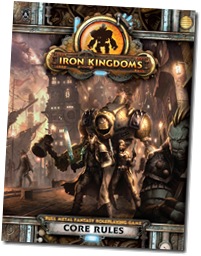 I recently was invited to play in a new gaming group and it was just my luck that they were playing the new Iron Kingdoms RPG. So for the last few days I have been reading through the new Iron Kingdoms Core Rules book graciously provided by my GM for the purpose creating my character and learning more about the game.. And I have to admit I have been smiling from ear to ear all the time. The new Iron Kingdoms Core Rules book is a 358-paged full-color hardcover book which contains all the rules and background needed to run games set in the Iron Kingdoms campaign setting. As expected from a Privateer Press product the production quality is extremely high. Artwork and layout are on par with what you’ve seen in any of the WARMACHINE products. It’s a pleasure just to leaf through the book and enjoy the artwork. Yes, it’s that good. The first section of the book (about 100 pages) focuses on the world of Caen in general and the area of Western Immoren in particular. You get a detailed description of the history of the Iron Kingdoms, the cosmology and an overview of life in Western Immoren. By the way, some of you might not have heard of the Iron Kingdoms before, so let me give you a short introduction: The world of Caen is not your regular fantasy world. Yes, there are the typical fantasy races you’d expect and yes, there is magic, but Western Immoen (which is the area the game is set in) also went through an industrial revolution, which led to all kinds of mechanical marvels like Steamjacks (coal-driven golems), trains, steam engines and firearms. The nations of Western Immoren which are also called the Iron Kingdoms were formed after the successful rebellion against the evil Orgoth Empire who had conquered the area four centuries earlier. Nowadays the Iron Kingdoms consist of the human nations of Cygnar, Khador, Llael, Ord, the Protectorate of Menoth, the dwarven nation of Rhul, Ios, the homeland of the elves and the hostile island nation of Cryx. The Iron Kingdoms are ripe for conflict and there are countless opportunities for adventures. 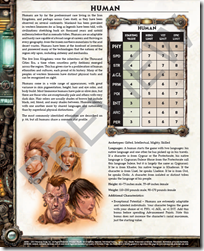 The second section of the book (about 70 pages) is all about characters. Character creation in the IK RPG is a pretty straight forward process but allows for a huge variety of different characters. You start by choosing your character’s race (Human, Dwarf, Iosan (Elf), Nyss (Elf), Gobber, Ogrun, and Trollkin). After that you pick one of the four archetypes: Gifted, Intellectual, Mighty and Skilled. Each archetype grants the character with a special ability (like an additional die on melee damage rolls in the case of the Mighty) and allows the player to pick once from a list of benefits (like Photographic Memory or Genius for the Intellectual). Archetypes also play a role when it comes to picking careers. Each character gets to pick two careers. Some careers have prerequisites (like Gifted only or Human only), but aside from that you’re free to mix and match. 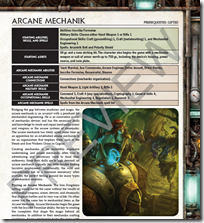 In my opinion the career system is a stroke of genius. It takes the best aspects of class systems but none of the inherent problems. Class systems have the advantage that they make things much easier especially for new players like myself. But often classes can also be restrictive in certain ways. The careers in the IK RPG provide the character with a set of skills, abilities, spells (if the career allows spellcasting) and starting gear. Each career also comes with a list of skills and abilities a character following said career can learn in the future. By combining two careers you basically get a huge number of different combinations that allow for a wide variety of character types. You want to play a noble mage? Then combine Arcanist with Aristocrat. Your perfect character started out as a priest but decided to join the military instead, why not combine Priest and Soldier? The following careers are in the book: Alchemist, Arcane Mechanik, Arcanist, Aristocrat, Bounty Hunter, Cutthroat, Duellist, Explorer, Fell Caller, Field Mechanik, Gun Mage, Highwayman, Investigator, Iron Fang, Knight, Mage Hunter, Man-at-Arms, Military Officer, Pirate, Priest, Rifleman, Soldier, Sorcerer, Spy, Stormblade, Thief, Trencher, and last but not least Warcaster. After picking your career you get to increase your character’s stats (each member of a race starts with the same stat profile) and then you can apply some finishing touches. What I like most about the system is that character creation is very quick and quite straightforward while still giving the players access to a huge variety of character concepts. The Character section of the book also contains an extensive description of all the skills and abilities and gives examples for target numbers with each skill. Then after creating your characters the party comes together and picks from one of the available Adventuring Companies. These companies not only provide a theme and some special benefits, they also give a reason why the characters are working together. Choosing an adventuring company is of course optional and subject to GM discretion, but it’s another idea that could help players and GM to get into the game quicker. The third section of the book covers the rules of the game. I have to admit that I was actually surprised that the general rules section (including combat rules) is just about 30 pages. Skill rolls are done by rolling 2d6 and adding the relevant Skill Level and Stat. The result is then combined with a target number set by the GM. The game gives examples for appropriate target numbers for all the skills, but an experienced GM may basically use handwaving to come up with target numbers if he or she wishes to. Especially when it comes to non-combat actions the crunch level is surprisingly low. Things get a bit more complex when combat is involved and the Iron Kingdoms RPG shows its kinship to the WARMACHINE miniature game here. If you have played WARMACHINE or HORDES before, you should feel right at home. The rules recommend that you use miniatures and a battlemap for combat, but there are also guidelines for people who prefer not to. Ranges are given in both inches (for miniature play) and feet, which is something I wish other games would have done as well (D&D 4th Edition I am looking at you!). Explaining all the various combat rules would probably be beyond the scope of the review. If you wish to get an idea of what combat in the IK RPG looks like, check out the WARMACHINE quick start rules which are freely available on the Privateer Press site. As you would expect from a combat system based on a miniatures game there are rules for every situation and there’s not a lot of room for GM fiat when it comes to combat. The combat rules are also a bit more crunchy than I usually prefer but it’s definitely less complex than games like D&D 3rd Edition. 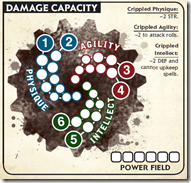 One aspect of the combat rules I like a lot are the Life Spirals. In the case of simple NPCs the game usually just uses Vitality points to track damage. But in the case of important NPCs and Player Character the Life Spiral is used. As you can see to the right each character has a life spiral with 6 branches grouped into three aspects tied to the character’s main stats: Physique, Agility and Intellect. Whenever a character takes damage, you roll a d6 to determine where you start marking off Vitality points. Are there no more unmarked Vitality points in the branch, you move to the next one clockwise. If all Vitality points are filled the character succumbs to his or her wounds. So what’s the deal with the branches then? When all Vitality points of a branch are filled the character suffers from the effects listed next to the Life Spiral. A crippled physique reduces a characters STR by two for example. It’s not as elaborate as other systems, but quite effective. Another thing I like a lot is the Injury Table you roll on after a character has been incapacitated. The long-term effects of the injuries the character sustained can reach from death (on a roll of 3 on 3d6) to being scarred or even crippled. The table in my opinion perfectly fits into the somewhat gritty feel of the Iron Kingdoms setting. 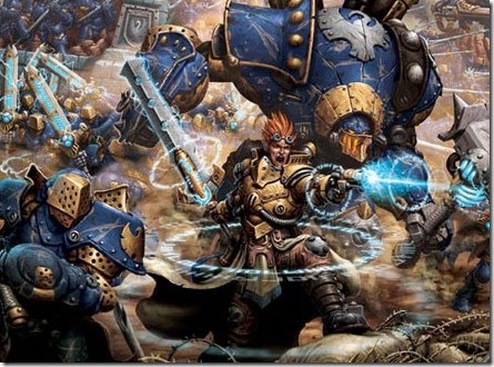 The next chapter in the book is about Magic. In the Iron Kingdoms there are two kinds of magic traditions: will weavers and focusers. Will weavers use their own willpower to harness arcane energies while focusers tap into the ambient magical energies around them. As a Gifted character you have to choose between those traditions. Will Weavers are a lot like the spell casters you know from other games, while focusers are a bit different. They can use their arcane energies to control steamjacks and also use their magic to boost attack and damage rolls (even for non-magical attacks). The book contains a quite extensive list of spells and each Gifted career has its own spell list. The only thing that bothers me a bit is that the spells are very combat focused and the spell descriptions are extremely short. Some more fluff texts would have been nice there. But this is nothing that couldn’t be remedied in later books. Gear, Mechanika, and Alchemy are the topics of the following chapter and again it’s one of the highlights of the book. The gear list covers everything your character could ever have dreamed of from a simple knife to Warcaster armor and the iconic Iron Kingdoms Great Coat. The rules for creating your own mechnika like mechanikal weapons or armor are another highlight of the book. For a lot of people (including me) the mechanikal marvels of the setting were what made us fall in love with the Iron Kingdoms, so having some crafting rules at our fingertips is a huge thing! The section on Alchemy starts by giving us some information on the origins and usage of Alchemy in Western Immoren and the rules needed to create Alchemical items in-game. There are basically sixteen primary ingredients alchemists can buy or gather which can be used to mix several alchemical items including grenades. The next chapter is all about Steamjacks, probably the most iconic aspect of the setting. Steamjacks are mechanikal constructs, not unlike golems in other settings, that are given the ability to think by a magical brain called the cortex. Steamjacks are usually powered by coal and can be commanded by simple spoken commands or by a Warcaster through telepathy. Steamjacks are used in all parts of Western Immoen. There are Laborjacks built for physical labor and the more elaborate military Warjacks. The chapter describes the components of Steamjacks in detail and provides rules for assembling and updating your own steamjack. In addition to that additional combat rules for steamjacks are given, which are – not surprisingly – based on the WARMACHINE rules for steamjacks. There are also rules for steamjack development. Yes, your Warcaster’s steamjack can get better over time and even develop a personality. Thumbs up! The last chapter is on “Full-Metal Fantasy Game Mastering”. Luckily it doesn’t try to give you game mastering advice you have heard thousands of times before but focuses on what you need to successfully run a game set into the Iron Kingdoms. There are guidelines on how to create NPCs, how to design encounters and the book gives you some advice on what kind of scenarios and campaigns to run. Last but not least some tips on how to play without miniatures are given. The book concludes with a very short bestiary that looks more like an afterthought than a proper bestiary, a couple of useful (and very good-looking) sheets and an extensive index. Overall the Iron Kingdoms roleplaying is exactly what I hoped for when I first saw the Privateer Press booth and information on Iron Kingdoms RPG at Gen Con this last year. The production value of the book is top-notch, the career system is pure genius and the background chapters are the most in-depth look on the Iron Kingdoms I’ve read so far. The combat rules are a bit on the crunchy side, but because of the compatibility to the WARMACHINE rules, veteran WARMACHINE players should have no trouble getting into the RPG as well. The only disappointing aspects of the book is the very short bestiary and the lack of an introductory adventure. Luckily Privateer Press already provided an expanded bestiary as a free PDF on their site. The Iron Kingdoms RPG by Privateer Press is definitely a must-have for every Iron Kingdom fan!
1 Comment
spitflame341
1/31/2013 09:29:19 am
They've also published a free starter adventure and quick-start rules on the same page as the expanded bestiary. It's called "Fools Rush In." As well, the No Quarter magazine (Issues 43 - 46) all have additional IK content, such as adventures, monsters, and expanded rules and fluff for 'jacks.
Reply
Leave a Reply. |
Archives
August 2021
Categories
All
|
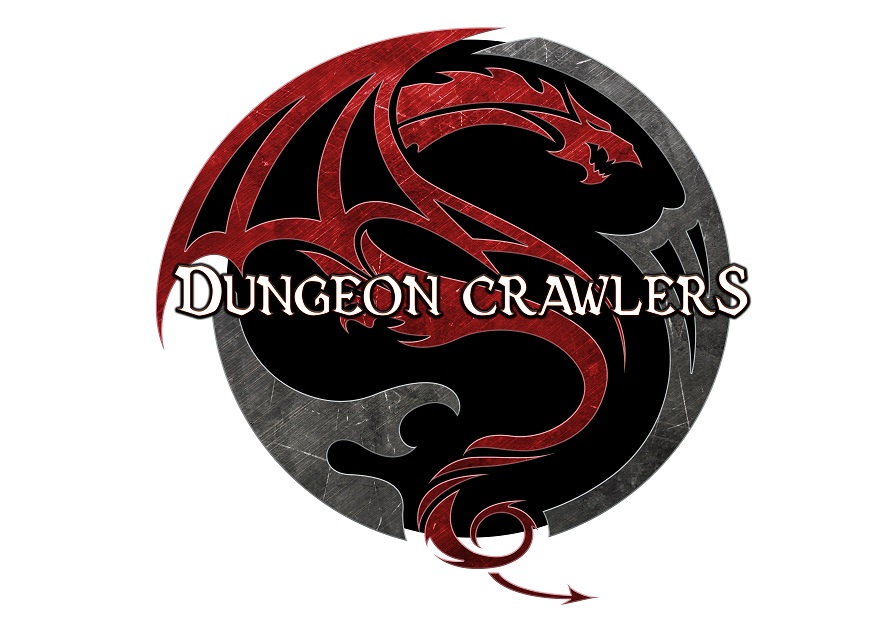
 RSS Feed
RSS Feed








